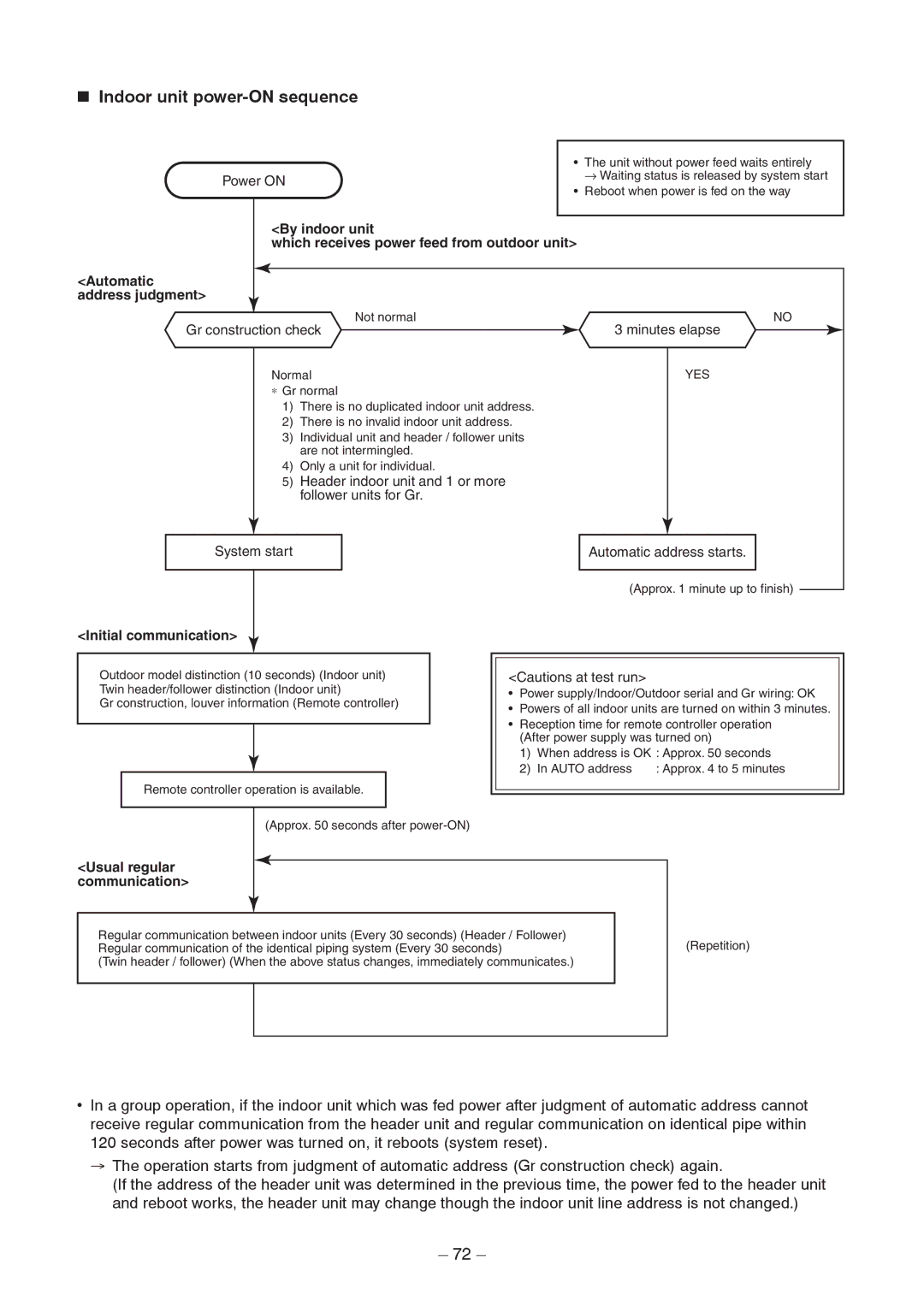Split Type
Contents
11-1
11-2
11-3
11-4
Original instruction
Explanation of indications
Explanation of illustrated marks
Work undertaken Protective gear worn
Indication Explanation
Confirmation of warning label on the main unit
Electrical Shock Hazard
Service person is allowed to do this work
Without first conducting these checks
Proceeding with the repair work
Discharged
Procedure in the ladders instructions
Protective gloves and safety work clothing
Telephone wires
Electric shocks, electrical leakage, smoking and/or a fire
Never recover the refrigerant into the outdoor unit
Wires as before
Refrigerant gas may catch fire
Do not use a welder in the closed room
Service panel
Before opening the service panel
Though the refrigerant gas itself is innocuous
Refrigerant leaks
Page
Explanations given to user
Relocation
Declaration of Conformity
Specifications
Safety Caution Concerned to New Refrigerant
Copper pipe Piping
Flare nut
Joint
Tools
General tools Conventional tools can be used
SM40, SM45, SM56 type SM80 type
Construction Views External Views
Page
Wiring Diagram
Parts name Type Specifications
Concealed Duct Type
Indoor Controller Block Diagram
Case of Connection of Wired Simple Remote Controller
Case of Connection of Wireless Remote Controller
Indoor unit #1 Heder Wireless remote controller
LCD
Outline of specifications Remarks
Temperature in heating
Setting at shipment
Room temp. control
Tc ≥ 60C, the fan speed increases by 1 step Temperature
Heat
Outline of specifications
Fan speed control
Heating ready is
Remarks
Tcj
Tcn
Tc n
Conditions
Setup at shipment
Mode when
Setup temperature on
Room temp. monitor
Case of wired remote controller
Case of wireless remote controller
Central
Goes on
Values of various sensors
Conditioner may stop or an error code may be displayed
Pushed for 4 seconds or more on the remote controller
When validating the save operation, the next operation
Starts with save operation valid because contents are
This function is set up at the customer’s side
MCC-1631
Indoor P.C. Board Optional Connector Specifications MCC-1631
Summary of Troubleshooting
Before troubleshooting
Troubleshooting procedure
Wired remote controller type
Wireless remote controller type
Outline of judgment
Lamp indication Check code Cause of trouble occurrence
Lamp indication Check code
Others Other than Check Code
Remote controller detected
Indoor unit detected
Central control devices detected
Check Code List
Error mode detected by indoor unit
Error mode detected by outdoor unit
Air conditioner
Operation of diagnostic function Check Status
Operation of diagnostic function Judgment and measures
Check code E01 error
E09 error
E04 error
E10 error
E18 error
E08, L03, L07, L08 error
L09 error
L20 error
L30 error
P30 error Central controller
P10 error
F10 error
P12 error
CN333 CN334
P19 error
Check by tester
Exchange to cooling cycle
Exchange to heating cycle
F02 error
F01 error
C06 error 11 model connection interface
E03 error Master indoor unit
F29 error
P31 error Follower indoor unit
Temperature Resistance value characteristic table
TA, TC, TCJ, TE, TS, to sensor
TD, TL sensor
TD, TL sensor
Part name Checking procedure
Position Resistance value
Replacement procedures
Case
Setting data read out from Eeprom
C. Board for indoor unit servicing replacement procedures
Contents
Code No. required at least
Writing the setting data to Eeprom
Refer to table Button for the temperature setting
Eeprom layout diagram
Setting data Type Type name abb
Setting data Type
Type Code No
Model Name RAV-SM∗∗∗BT-ETR
Test Run Setup on Remote Controller Wired remote controller
Wiress remote controller
Indoor Unit
Practical operation
LED Display on Indoor P.C. Board D501 Red
D403 Red
Function Selection Setup
Using the set temperature
To change the selected indoor unit, proceed to Procedure
To change item to be set up, proceed to Procedure
Item No. DN table Selection of function
Description At shipment
Description At shipment
Wireless remote controller
When connected 2 remote controllers operate an idoor unit
When connected 2 remote controllers operate the twin
Remote controller address A-B selection setting
Wireless remote controller A-B selection
Wireless remote controller B setup
Contents
„ Calling of error history Contents
Order to monitor another error history, push the set
Temperature Buttons to change the error
Pushing
„ Indoor unit power-ON sequence
Initial communication
Usual regular communication
Microprocessor block diagram
Model connection interface wiring connection
Model Connection Interface TCC-LINK adapter
Model name TCB-PCNT30TLE2
Wiring Specifications
C. Board Switch SW01 Setup
Use 2-core with no polar wire
To prevent noise trouble, use 2-core shield wire
How to set up from indoor unit side by remote controller
External view of P.C. board assembly
Address setup
Push Test + Vent buttons for 4 seconds or more
Page
Address Setup
Address setup procedure
System configuration
Address Setup & Group Control Terminology
Single
Triple Single group operation
Example
It is not influenced by the line 2 or 3 address indoor unit
Automatic Address Example from Unset Address No miswiring
Only turning on source power supply Automatic completion
Standard One outdoor unit
Multiple groups operation
Using timer time Buttons, set the line address
Push SET + CL + Test buttons
Simultaneously for 4 seconds or more
Folloer unit Push
Procedure
To know the position of indoor unit body by address
Button if the unit stops
Fan and louver of the selected indoor unit only operate
Part name Procedure Remarks
Detachment
Attachment
Suction panel
Electric parts
Cover from the projection of the side plate
Then remove the cover
Box
Control P.C
Board
Remove connectors for fan motor wiring
Fan motor
From control P.C. board
Match the fan motor with turning direction
Float switch
Drain pan
Drain pump
Attachment
Position and fix it as before, using screws
Heat
Perform works of 1
Set the heat exchanger at the original
RAV-SM406BT-E, RAV-SM456BT-E, RAV-SM566BT-E
Location Description Model Name RAV
SM456BT-E SM566BT-E
RAV-SM806BT-E
Location Description Model Name
RAV-SM406BT-TR, RAV-SM456BT-TR, RAV-SM566BT-TR
SM456BT-TR SM566BT-TR
RAV-SM806BT-TR
RAV-SM806BT-TR
Location Model Name RAV Description
SM406BT-E SM456BT-E SM566BT-E
RAV-SM1106BT-E, RAV-SM1406BT-E, RAV-SM1606BT-E
Location Description Model Name RAV SM1106BT-E
100
RAV-SM1106BT-TR, RAV-SM1406BT-TR, RAV-SM1606BT-TR
101
RAV-SM1106BT-E TR, RAV-SM1406BT-E TR, RAV-SM1606BT-E TR
Check of Concentration Limit
Toshiba Carrier Corporation

